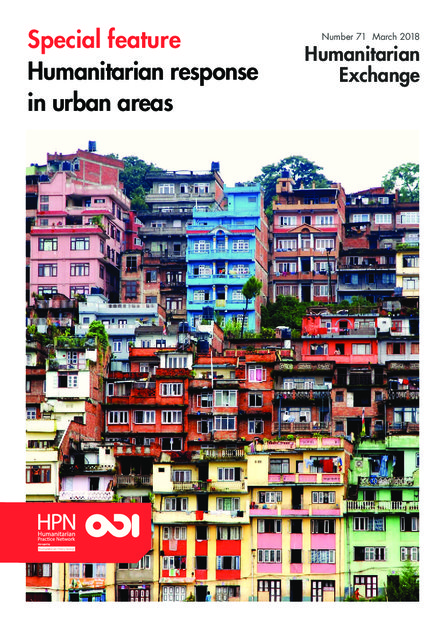
Humanitarian crises are increasingly affecting urban areas either directly, through civil conflict, hazards such as flooding or earthquakes, urban violence or outbreaks of disease, or indirectly, through hosting people fleeing these threats. The humanitarian sector has been slow to understand how the challenges and opportunities of working in urban spaces necessitate changes in how they operate. For agencies used to working in rural contexts, the dynamism of the city, with its reliance on markets, complex systems and intricate logistics, can be a daunting challenge. Huge, diverse and mobile populations complicate needs assessments, and close coordination with other, often unfamiliar, actors is necessary.
But what precisely is different about doing humanitarian assistance in urban settings? Alyoscia D’Onofrio reflects on this question in his lead article. John Twigg and Irina Mosel emphasise that engaging with and supporting informal actors is key to achieving greater accountability in urban areas, while Leah Campbell and Wale Osofisan both highlight the need for context-relevant responses. Samer Saliba describes the International Rescue Committee (IRC)’s experience in developing partnerships with municipalities, David Sanderson and Pamela Sitko outline ten principles for enacting area-based approaches in urban post-disaster recovery and Chris Pain and Hanne Vrebos discuss Concern’s area-based programme in Port-au-Prince. Ruta Nimkar and Mathias Devi Nielsen look at a new programming approach in urban centres in Afghanistan to address the needs of the long-term displaced. Learning from an urban earthquake simulation exercise in Dhaka is the focus of articles by Charles Kelly and Herma Majoor and Larissa Pelham, who conclude that, to maximise the usefulness of such exercises, more advance training, engagement and preparation is needed. In their article, Jonathan Parkinson, Tim Forster and Esther Shaylor underscore the benefits of using market analysis to support humanitarian WASH programming in urban areas. The edition ends with an article by Estella Carpi and Camillo Boano analysing the potential unintended consequences of the increasing urbanisation of humanitarian response, focusing on border regions neighbouring Syria.
Links
Resource collections
- Coordination
- Topics
- UN Habitat - Urban Response Collection
- Urban Response - Urban Crisis Preparedness and Risk Reduction
- Urban Response Collection - Community Engagement and Social Cohesion
- Urban Response Collection - Economic Recovery
- Urban Response Collection - Environment and Climate Change
- Urban Response Collection - Housing, Land and Property
- Urban Response Collection - Urban Crisis Response, Recovery and Reconstruction
- Urban Response Collection - Urban Resilience
